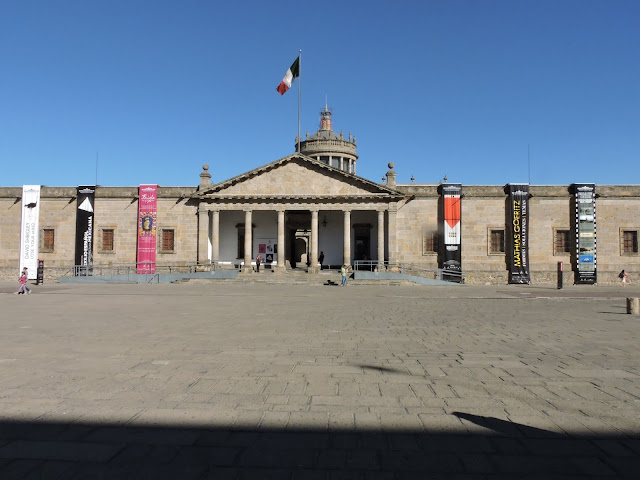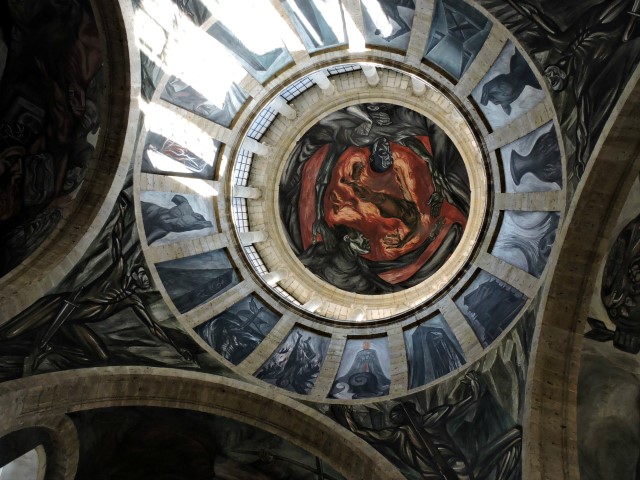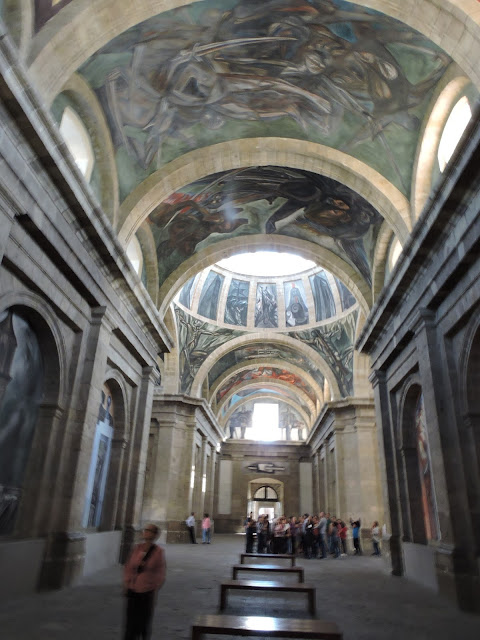January 2016 - Guadalajara Mexico
Today I’ll take you on our first walk in Guadalajara, last
Sunday. In spite of a late start and a carriage ride we still manage to cover 12,729 steps or 9.4 km.
First a brief overview of Guadalajara. Guadalajara is a city in western Mexico. It’s known for tequila and mariachi music, both born in Jalisco, the state of which Guadalajara is the capital.
The city is named after the Spanish city of Guadalajara, the name of which came from the Andalusian Arabic wād(i) l-ḥijāra (واد الحجارة or وادي الحجارة), meaning "river/valley of stones". The city's economy is based on industry, especially information technology, with a large number of international firms having manufacturing facilities in the Guadalajara Metropolitan Area. Other, more traditional industries, such as shoes, textiles and food processing are also important contributing factors.
It is at 5,138 feet above sea level.
Our hotel, Hotel Morales, I would highly recommend it.
After a late breakfast we head across the street to San
Francisco church.
We don’t quite make it as we are approached by a carriage
driver for a tour.
The carriages are known as calandrias.
We decide that it would be a great way to get oriented so
off we go.
The driver has limited English but points out points of interest. He
is also good about stopping when we request. I won't go into detail as we will revisit most of these places on foot later.
Click here for many more photos of this magnificent jewel.
Not sure what the name of this church is and we didn't go back to find it. John hopped out and took these photos.
That is a fantastic mural in the background that I will feature later.
We are back at the square around 1 PM and head out loosely
following the route our carriage took.
Guadalajara’s historic center is dotted with colonial plazas and landmarks like the neoclassical Teatro Degollado and a cathedral with twin gold spires.
The city exudes a distinct European atmosphere, and the Tapatíos, as the people of Guadalajara call themselves, have left their own distinctive mark on its broad avenues, carefully tended parks, and attractive light-colored buildings.
The Palacio del Gobierno houses famous murals by painter José Clemente Orozco.
As we approach the building a bride and
groom enter to register their marriage.
The building is open to the public and we walk around. These are the impressive murals on the walls and ceilings as you climb the
stairs.
We stop for some photos of the cathedral and then into the
square in front of the world renown theatre. Over the Christmas holidays they
had a skating rink set up which would have been great to see. But they are in
the process of dismantling it. The ice has been melting away for a few days. It
will totally be gone by the end of the week.
The mimes are keeping the kids amused.
The theatre is closed so we can only peek inside.
Along the pedestrian street there are lots of Sunday
shoppers. But we are more interested in the various statues and sculptures.
This bronze sculpture of two rampant lions posing victoriously with their paws on an oak tree is Guadalajara's coat of arms. Next to it two six-meters plaques display the decree by King Charles I of Spain and V of Germany recognizing the city and crest.
I truly thought this was a statue until I saw John drop some coin into the "basket" at his feet. Certainly startled me.
You could rent these cars for children. I liked the father son hair style.
We pass a restaurant we had been told about, Chavas and Charlie’s so we decide that will be our spot for dinner tonight.
This bronze sculpture of two rampant lions posing victoriously with their paws on an oak tree is Guadalajara's coat of arms. Next to it two six-meters plaques display the decree by King Charles I of Spain and V of Germany recognizing the city and crest.
We pass a restaurant we had been told about, Chavas and Charlie’s so we decide that will be our spot for dinner tonight.
As we get to the end of the mall I am so excited to see an exhibit I had read about. Click here to see lots more photos of the chairs.
We pay the admission fee and a camera fee and enter the Hospicio Cabañas is a World Heritage Site, is one of the oldest and largest hospital complexes in the Americas.
The complex was founded in 1791 by the Bishop of Guadalajara in order to combine the functions of a workhouse, hospital, orphanage, and almshouse.
The highlight of the interior decoration is a series of monumental frescoes by José Clemente Orozco, including one of his most famed creations, the allegory of The Man of Fire (1936–39). This is the same muralist as above at the Palacio del Gobierno. I have just learned that Orozco was one of Frida Kahlo's earliest supporters.
The complex was founded in 1791 by the Bishop of Guadalajara in order to combine the functions of a workhouse, hospital, orphanage, and almshouse.
When we step back outside this young girl is having her photos taken for her Quinceañera (Spanish pronunciation: [kinθeaˈɲeɾa]; feminine form of "fifteen-year-old"), also called fiesta de quince años, fiesta de quinceañera, quince años, quinceañero or simply quince, is a celebration of a girl's fifteenth birthday in parts of Latin America. We come across many of these photo shoots around any Mexican city.
This birthday is celebrated differently from any other as it marks the transition from childhood to young womanhood. Latin myths and tradition tell about how girls were prepared to be married by the age of fifteen or become nuns. In the years prior to their fifteenth birthdays, girls were taught to cook, weave, and about child rearing by the elder women in their communities in preparation for their expected lives as married women.
.

The quinceañera is expected to wear a formal evening dress, traditionally a long, elegant ball gown chosen by the girl and most often, her mother, according to her favorite color and style.
In the Mexican Catholic tradition, the quinceañera celebration begins with a thanksgiving mass. She arrives at church accompanied by her parents, godparents, and court of honor. The court of honor is a group of her chosen peers consisting of paired-off girls and boys, respectively known as damas (dames) andchambelanes (chamberlains).
Here she is again, later in the afternoon at another venue as we slowly meander back towards the cathedral.
We stop back at the theatre bar, we had been told by George
it is a must stop for people watching and it couldn’t have been better on a
sunny Sunday afternoon as all the families are out enjoying themselves.
I try a Michelada for the first time and love it. There is a saxophone player playing great music.
They love shoes!!

























































































This has been a wonderful stroll! I enjoyed every photo, it felt like I was there with you. Delightful!
ReplyDeleteThe architecture there is tremendously appealing!
ReplyDeleteI've been singing a certain song by Steely Dan all the way through this post, Jackie, and now I feel as if I've been to Guadalajara too. :) I've admired your header photo for a while too, not to mention that fabulous 15 year old! Many thanks for sharing.
ReplyDelete